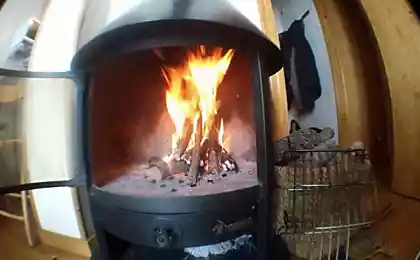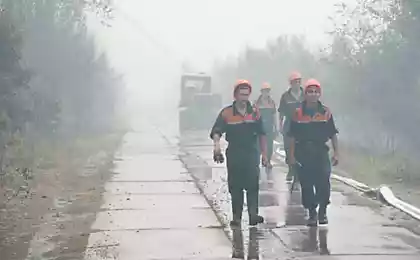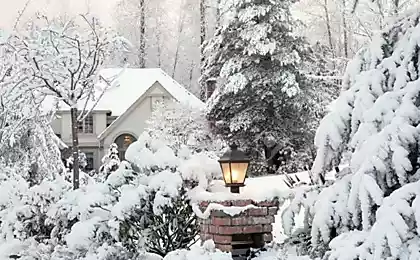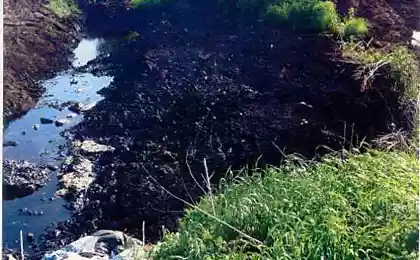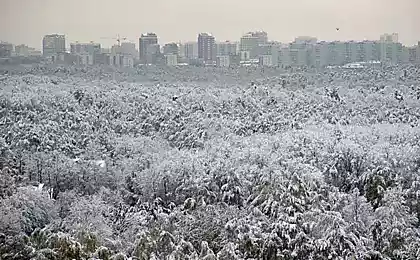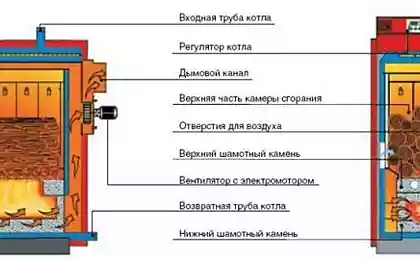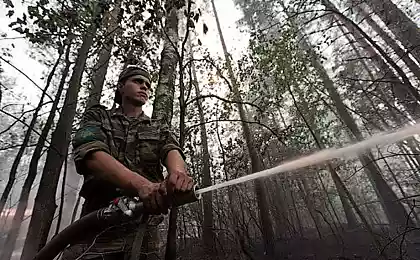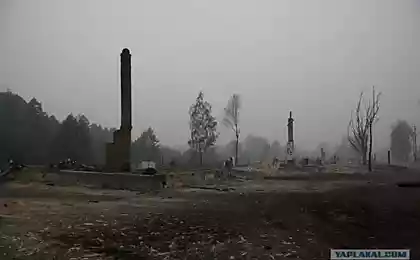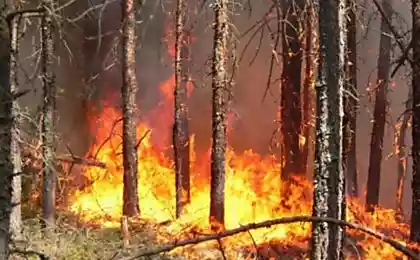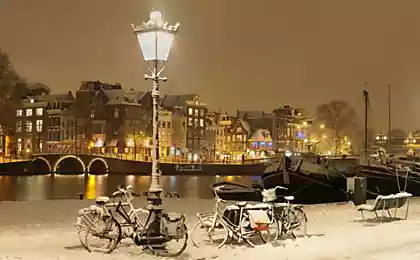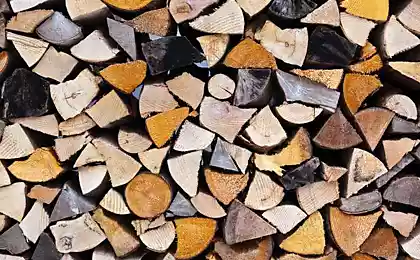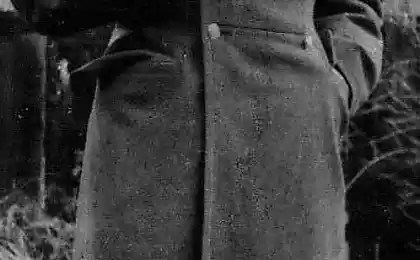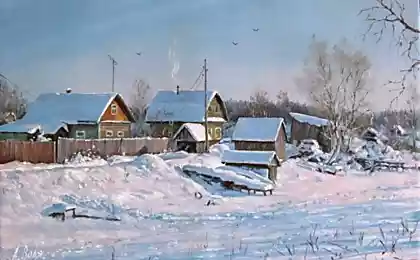840
Peat bogs are burning in the suburbs, even in winter!
History and 49 photos © Igor Podgorny
In summer 2011, forests and peat bogs near Moscow will again burn! It would not have comforted us by representatives of Roshydromet, no matter how many awards did not receive MOE officials, forest and peat about it do not know. They light up again as soon as the snow will melt. Moreover, peat bogs, and did not cease to burn. Back in November I wrote about the situation near Yekaterinburg (there is going to extinguish the peat is collected from the streets of snow).
And last Friday, we drove through the Lukhovitsy district of Moscow region in the vicinity of settlements Olshany and moss, along the road connecting the villages and Riasanovsky Beloomut and saw with my own eyes: burning peat. In the air is the characteristic smell that haunted us in the summer. Even the road here and there visible smoke. And this is where the power of the peat is quite small - a few tens of centimeters. About what is happening in the body of peatlands can only guess. We could not get there by car, but be sure to try to repeat in the near future.
Do they know that burning peat government and FEMA. They know, but do not hurry to recognize that this is a problem. Perhaps hoping for dozhlivoe summer, maybe just do not want the hassle, perhaps hoping that "will resolve itself." It does not resolve! And today it is necessary to prepare for the hot summer-2011.

Dead wood along the route. I showed photos from this autumn. And then it looked horrible, and now especially so because of the contrast of the image
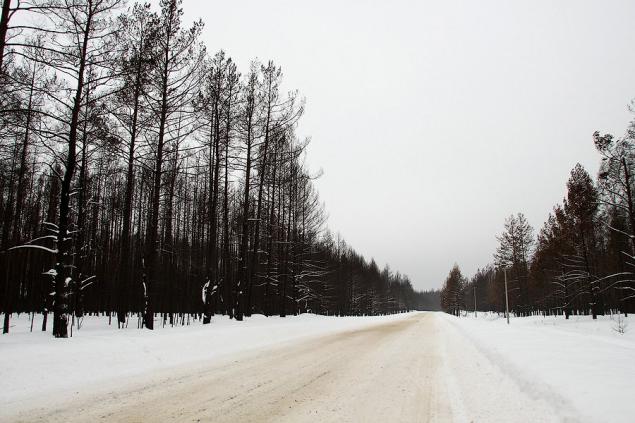
03
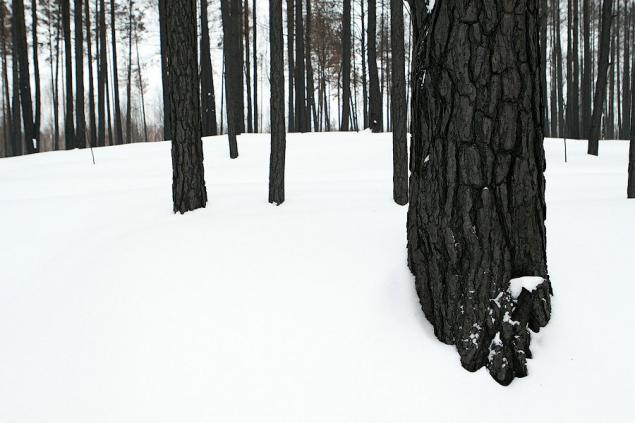
04

05
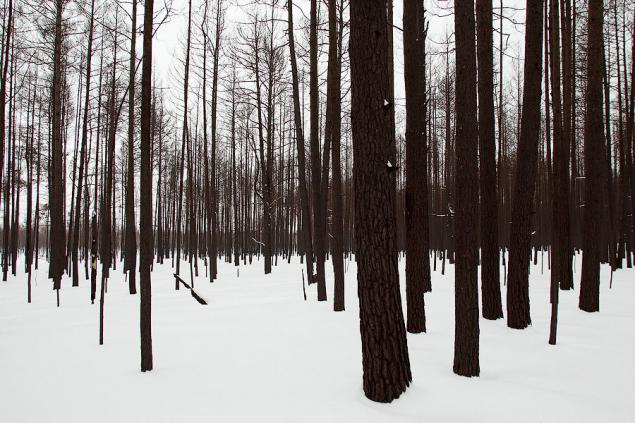
06

07
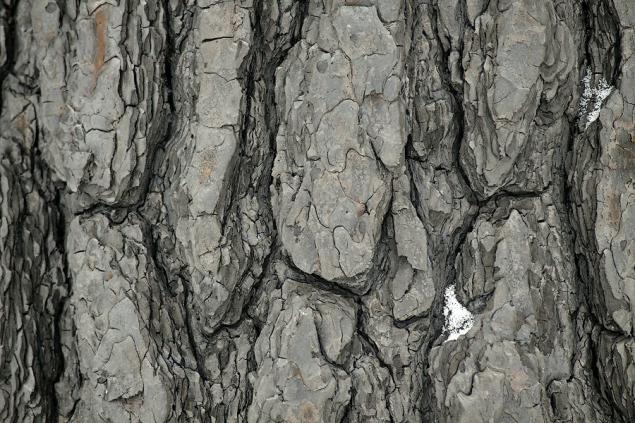
08
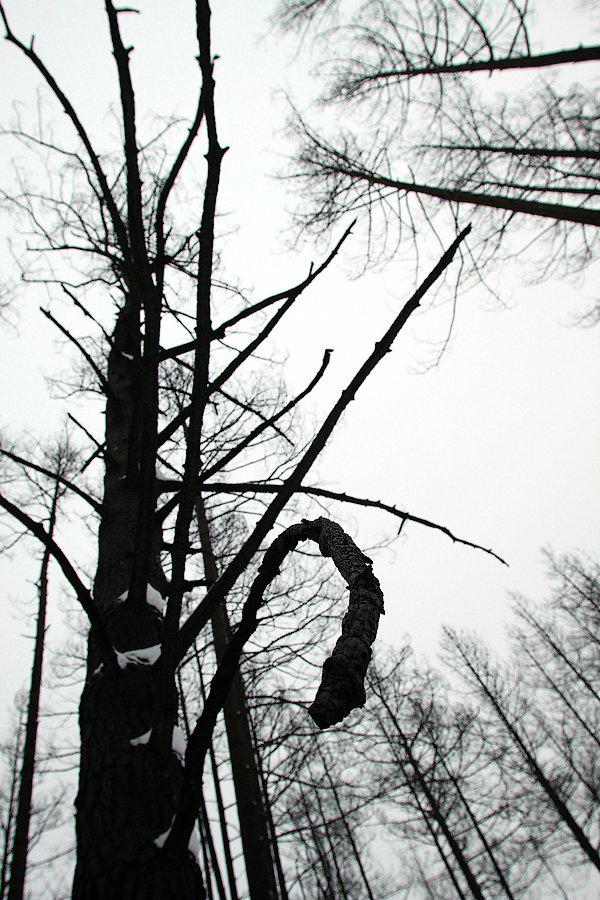
09
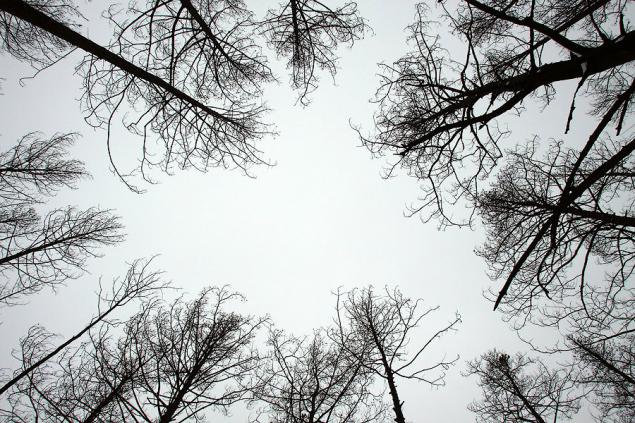
Infamous Mokhovoe. The village burned for half an hour on July 29 last year.

11

12

13
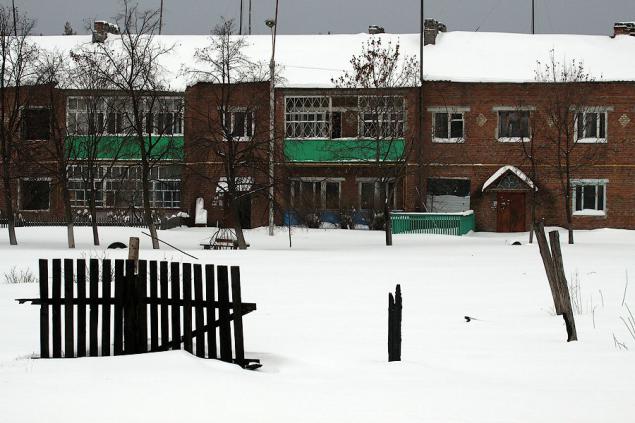
14
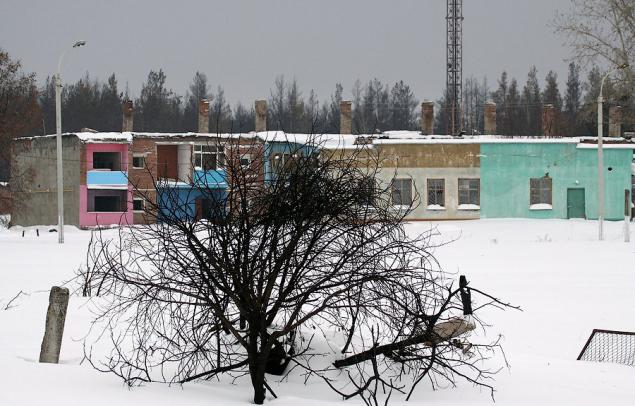
15
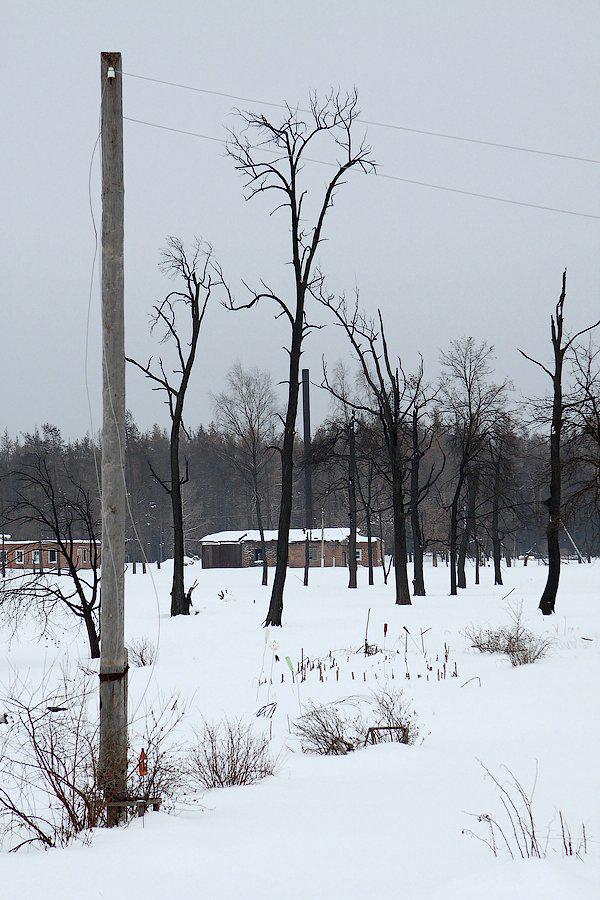
16
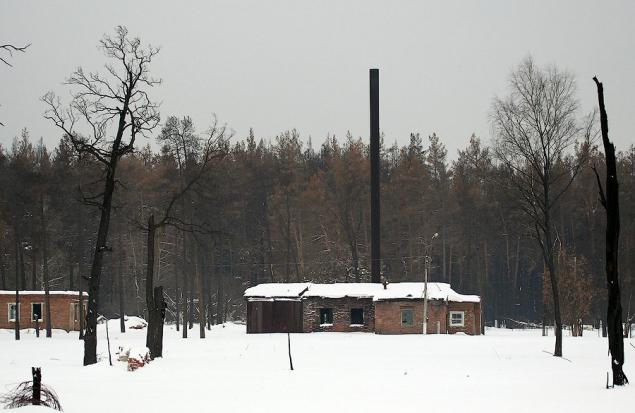
17
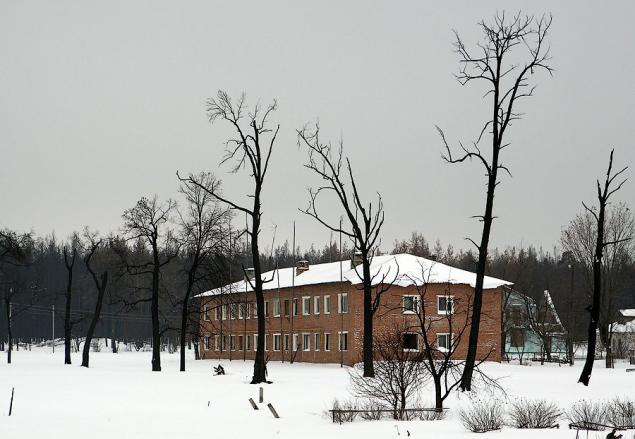
18
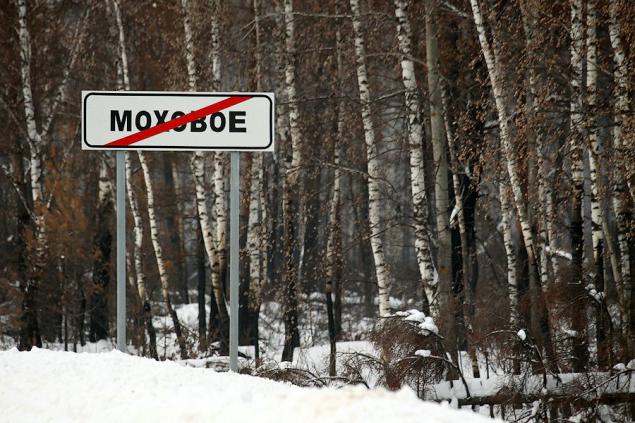
And this is how looks the way smoke from burning peat.

20
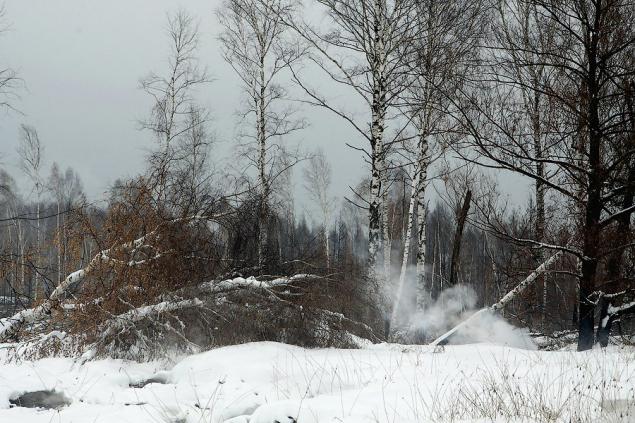
21
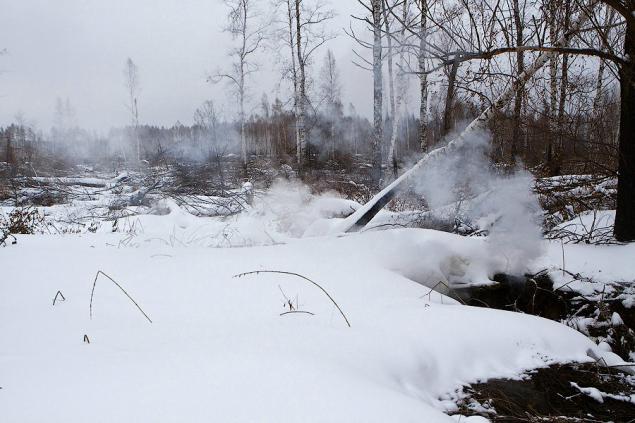
In such places there is no snow.
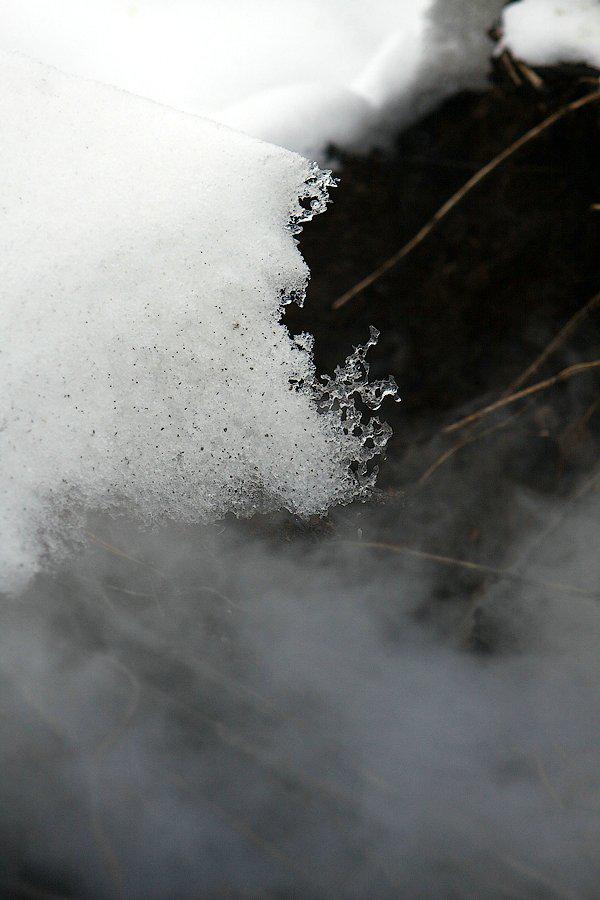
A sort of "peat thawed." Even the grass is green somewhere preserved.
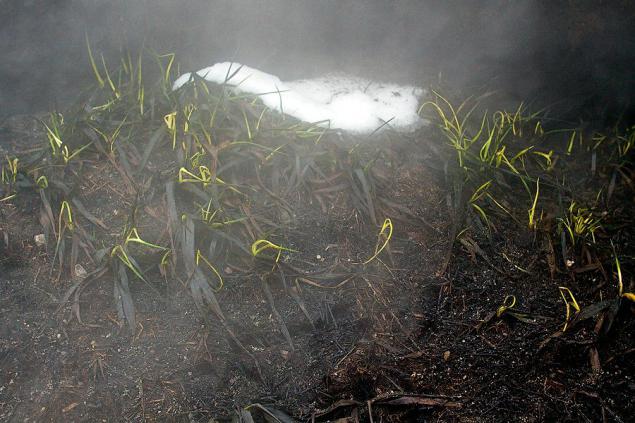
24

These unsorted debris will be an excellent fuel for new fires.

"Dumped Forest" - along the road only a few pieces of baldness.
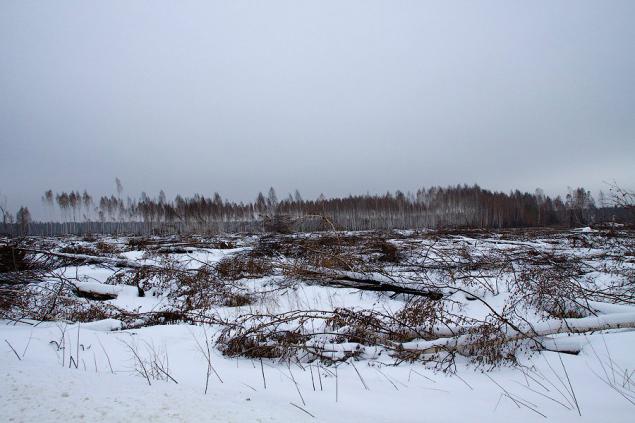
27
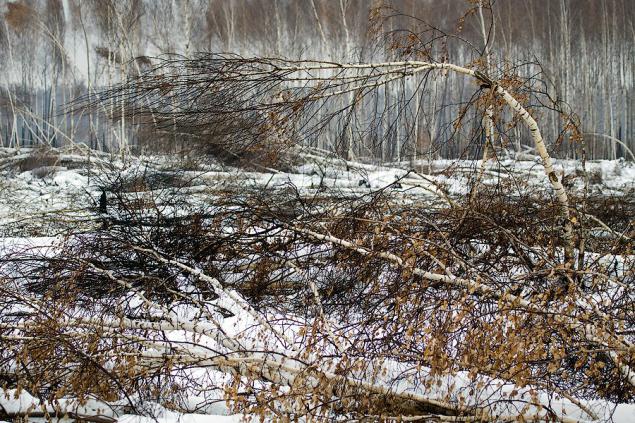
usovevg at work.

Another sad sight - dead landing.
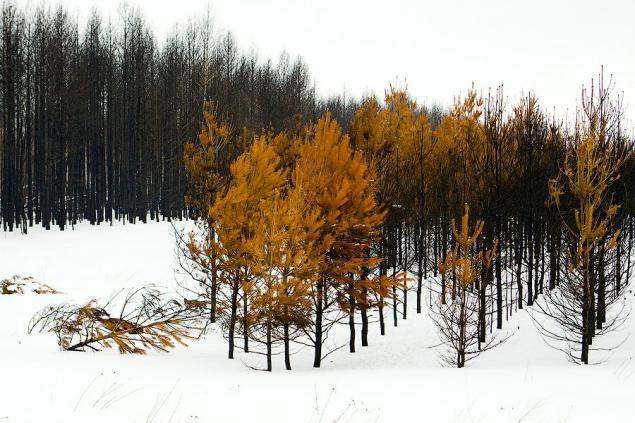
30
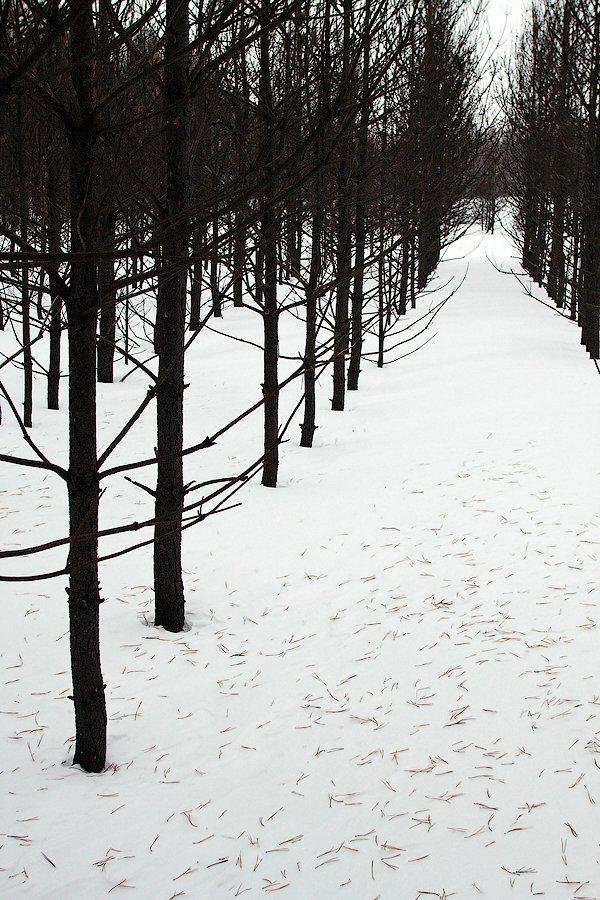
Houses holiday village "Star". We extinguished peat in September.
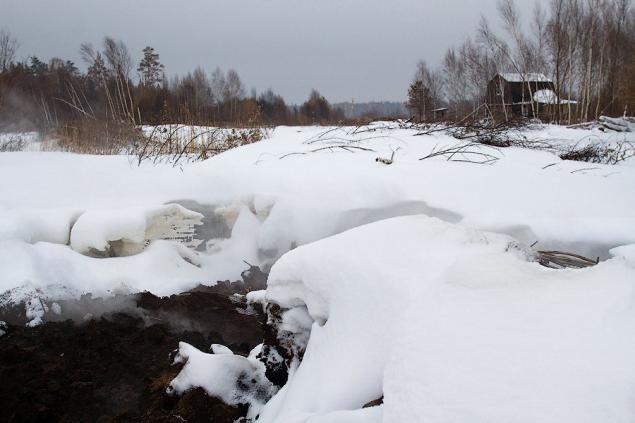
In several places smokes here.
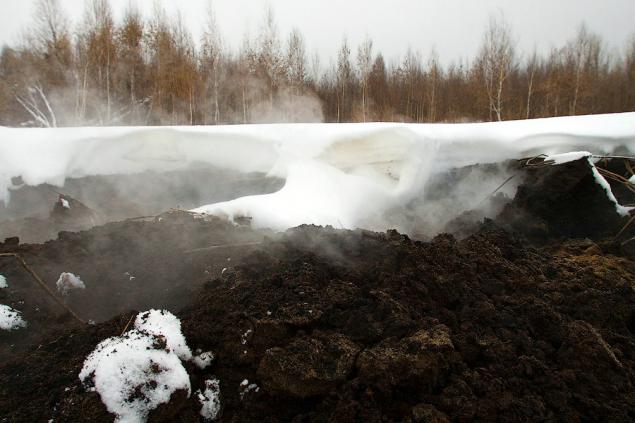
33
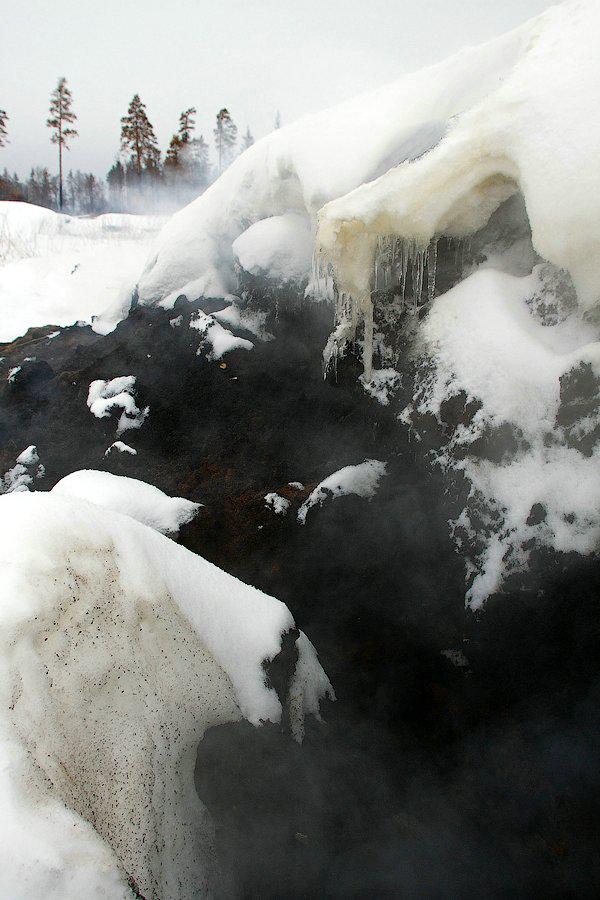
One of the goals of our trip was the peat samples to further define its humidity.
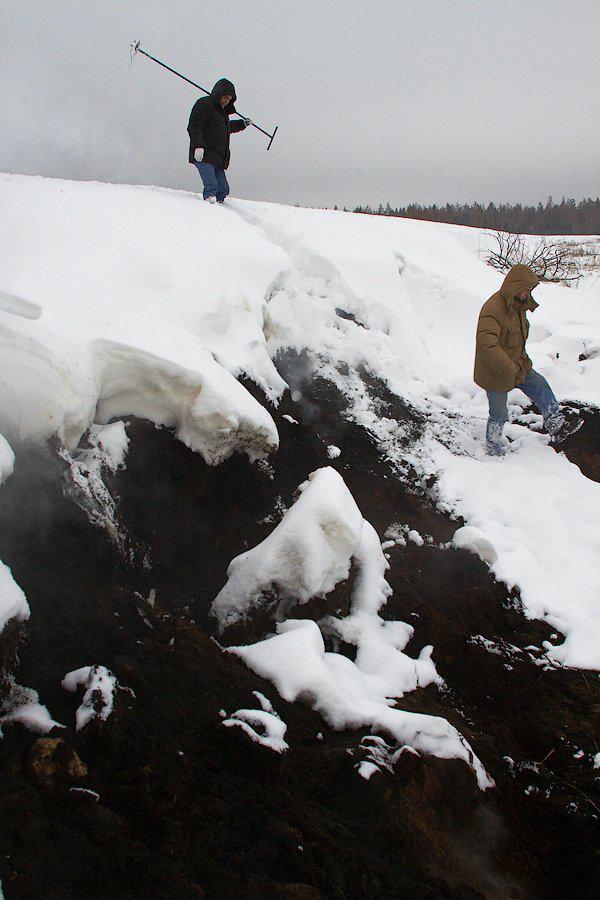
Samples were taken just such a giant "corkscrew»))
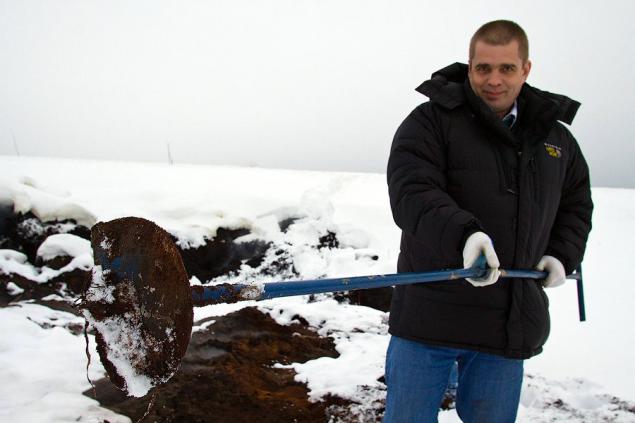
Driller morskoy_pesik
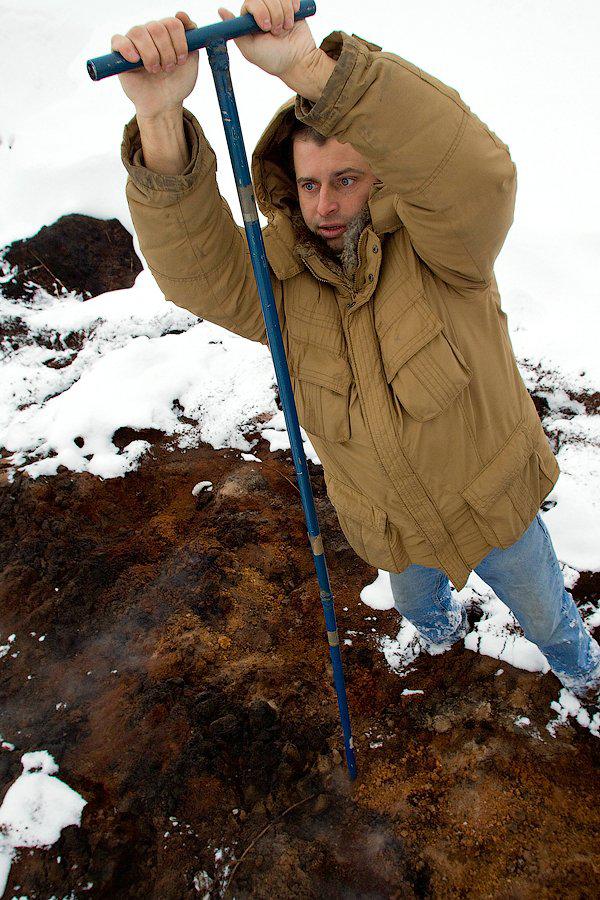
37
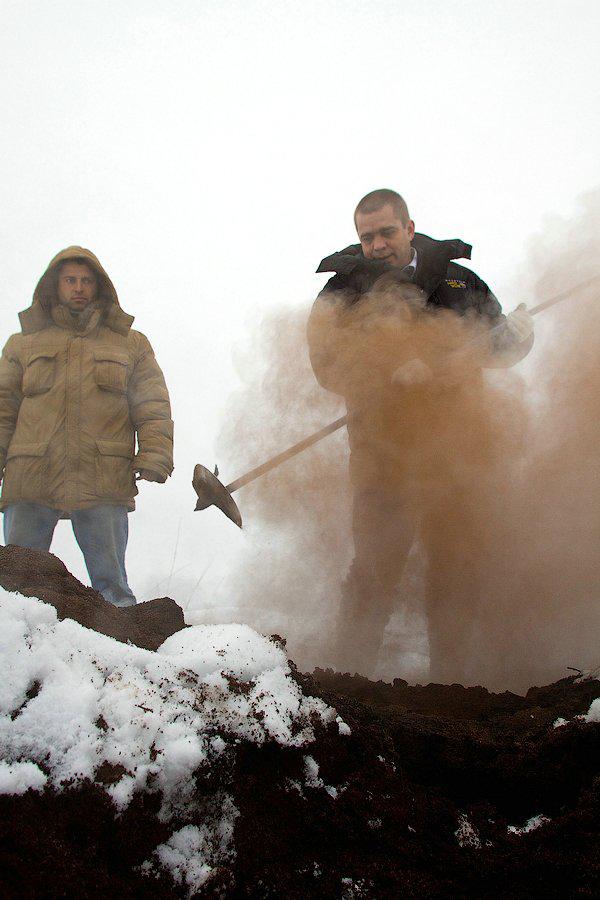
38

39
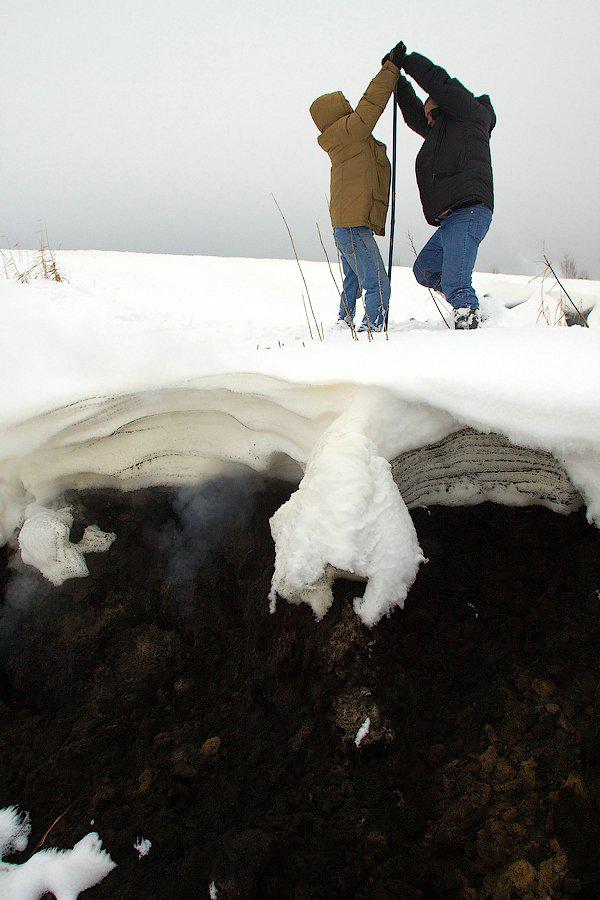
40
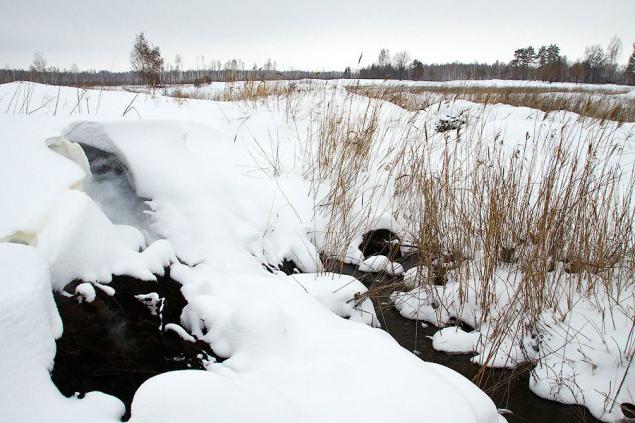
41
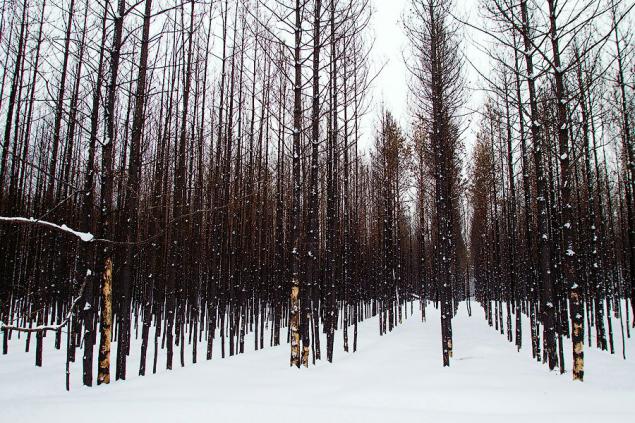
Another section of the burned forest. Around 15 kilometers from the village Radovitsky.
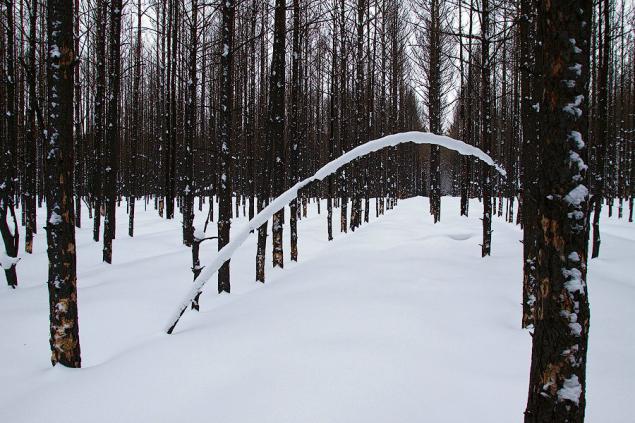
43
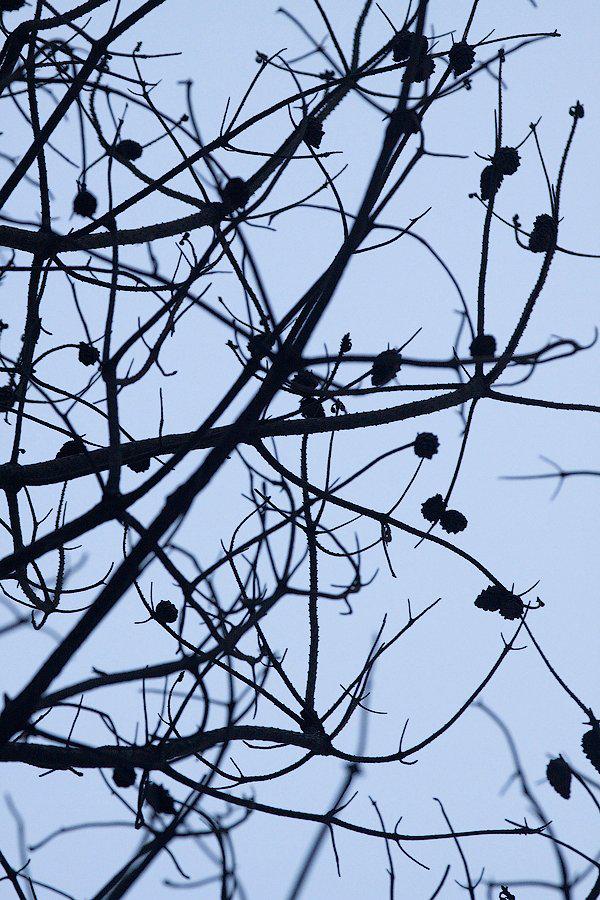
A little further are even entire trees. But next year they, alas, has all chances to become like the photo above.
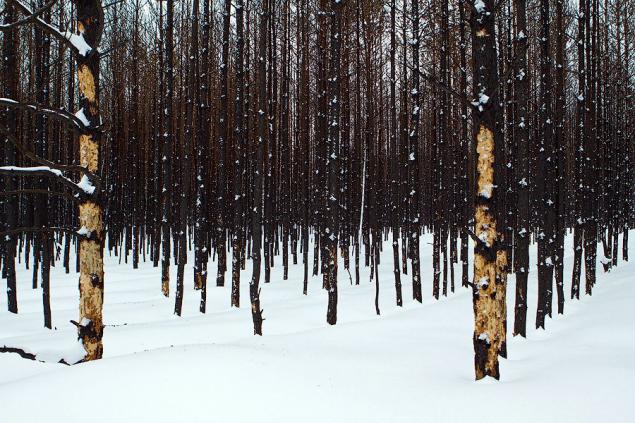
45

46
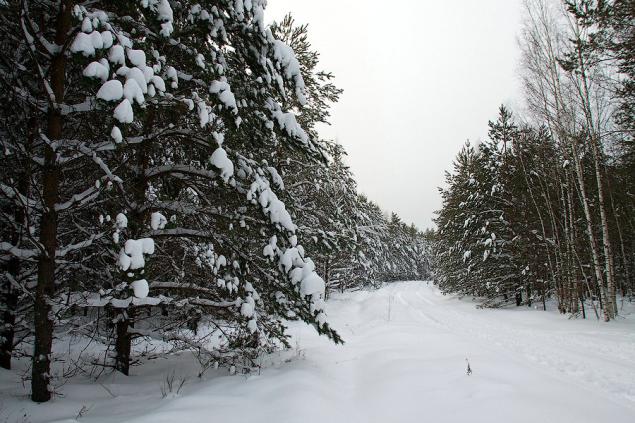
47
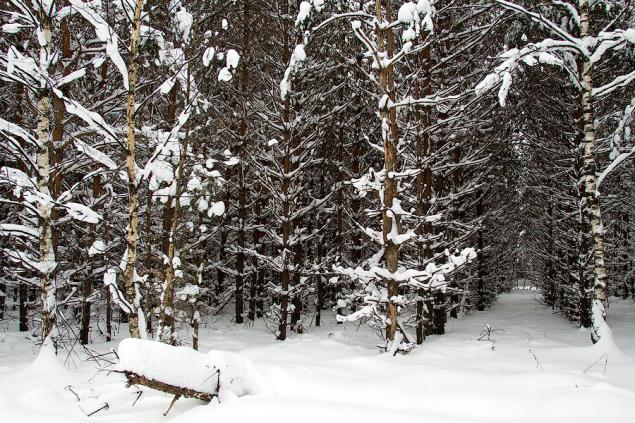
As I said, we were not able to get into the central part of the moor, even on our pepelats.

But we will come back to this region.
All photos: © Igor Podgorny
Drained peat bogs in the Moscow region continued to smolder, there is a risk of burning the resumption of the spring
Peat bogs in southeastern Moscow continues to smolder to this day. There remains a significant risk of renewed fires in the spring of 2011, after the disappearance of the snow cover, drying of the surface layers of drained peatlands and the debris of dead wood in the burned areas in summer 2010.
January 14 employees of Greenpeace Russia checked the pockets of smoldering peat Lukhovitsy district of Moscow region in the vicinity of settlements Olshany and moss, along the road connecting the villages and Riasanovsky Beloomut. From the powerful summer peat fire in the area within sight of the highway remained dozens of disparate pockets of smoldering peat dedicated to various enhancements and well-drained sites (dumps drainage ditches, roadside and others.). In places the snow thaws corruption to the surface peat. In four outbreaks in the vicinity of the highway, hand-drill wells were drilled to mineral soil underlying peat, in order to clarify what the power and the humidity of the peat deposits in the vicinity of the centers of corruption in the centers themselves. It turned out that two of the four seats of the residual capacity of peat is less than 30 centimeters and homes to spread corruption nowhere - they are guaranteed to be filled with water during the spring thaw, if not sooner. The other two centers of power peat more, and it is likely that corruption will continue until the new peat fire season. In the central part of Radovitsky drained bog moss these lesions can survive the spring snowmelt, can be much larger.
Drained peat bogs by fires of the summer of 2010, now represent a huge area, littered with charred dead wood, including in the areas immediately adjacent to some of the surviving homes smoldering peat. No signs of clearing burnt wood on peat, or pre-clearance, is not revealed. On adjacent to the swamp system of mineral lands of the forest, passed the fire, and basically died, but has not yet spilled. Some of these forests assigned to the sanitary clear cuttings, but the cuttings are not conducted. A significant part of forest preserved in the vicinity of the village watching Ryazanov not affected by the fires in 2010, is a culture of pine second age class with a lot of dead branches and dead organic matter on the soil surface.
There were no signs of work to extinguish remaining pockets of smoldering peat in this area is not detected.
Background.
Radovitsky moss bog system is at the crossroads of two regions (Moscow and Ryazan), and within the Moscow region - at the junction of three districts (Shatura, Yegoryevsky and Lukhovitsky). Drainage systems Radovitsky bog moss was started in the late XIX century Western expedition to drain the swamps led by General I.I.Zhilinskogo. Initially draining carried out in order to create conditions for the development of agriculture and forestry, as well as for the alloy timber on large drainage channels (in particular, via Žilina). In the 30 years of the twentieth century, dehumidification continued, this time with the aim of peat extraction. Around the 70-ies The twentieth century began the gradual dying peat industry (peat as fuel was not competitive in comparison with the gas), and the 90-ies peat bog system within Radovitsky moss almost ceased. Since peat is mined places in symbolic quantities for use in agriculture. Large Peat supporting infrastructure bilge, fire reservoirs and ensured the some level of protection from fires of peat bogs, have ceased to exist. Territory of the former peat bog system within Radovitsky moss in the Moscow region is now almost fully attributed to the lands of the forest fund.
From the time of General Zhilinsky drained bog system Radovitsky moss repeatedly burned. The most catastrophic fires, leading to a large loss of life occurred in 1936, 1972 and 2010
Since when has started to burn peat bog system within Radovitsky Moss in 2010, it is not precisely known (seems most likely that the first pockets of smoldering peat emerged in the first half of May). Close peat fire, apparently out-of-control, was recorded by satellite images (system FIRMS) in early July. On July 14, four kilometers east of the village watching Ryazanov has acted peat fire on an area of several hundred hectares, the fire quickly spread and covers all the areas. General Directorate of Ministry of Emergency Situations in the Moscow region at the time reported that "over the past day in the Moscow region emergencies not happened," and that peat fires are detected and eliminated (the information was repeated every day; now the official website of EMERCOM in Moscow These field reports deleted). Attempts to extinguish the fire were made, but the forces of forest workers and local fire department was too small to deal with such a powerful peat fire. For fire fighting aircraft has been used as the MOE, but the burning of peat on this area and in such a strong smoke its application could not be effective.
Until the end of July, a fire in the territory of the marsh system Radovitsky Moss continued to expand, and new hotbeds of burning peat. July 29 as a result of a sharp increase in the wind the fire quickly spread to a large area. As a result, burned villages and Kadanok Mokhovoe were killed according to official figures 10 people, according to unofficial - not less than 15.
Thereafter forces involved in the extinguishing of fires in the area, has been drastically increased (largely by volunteers, have no connection with official structures), the further spread of the fire was able to largely stop.
Throughout August 2010 EMERCOM in Moscow Region and the leadership of the ministry to report impressive success in extinguishing fires, while their actual size remained virtually unchanged until the beginning of the heavy rains in the late summer. August 8, 2010 Ministry of Emergency Situations Sergei Shoigu Minister said that his ministry "wanted a week dodavit fires" in the Moscow region. Already August 15 Ministry of Emergency Situations reported that the area of peat fires in the Moscow region was only eight hectares. August 19 Minister Shoigu held a final meeting of the Federal Emergency Headquarters at the Emergency Situations Ministry of Russia, which was officially announced that "in Moscow, Ryazan, Nizhny Novgorod region, the Republic of Mordovia setting wildfires fully normalized».
Peat meanwhile continued to burn even after heavy rains in late August and September. In early October, in the central part Radovitsky moss were still pockets of smoldering peat that gave the smoke plume is visible even on satellite images of low resolution. Gradually smoldering peat became less intense due to heavy rain and snow, arrays smoldering peat turned into isolated pockets, but these foci were observed within the vast territory traversed by fire in summer 2010.
Until the end of December 2010 the smoldering peat is only a concern of the local population, environmental organizations and forestry professionals. However, December 27 at the official website of the Ministry of Emergency Situations has been placed Forecast emergency situation in 2011, which not only recognized the existence of pockets of smoldering peat, but also spoke of the danger of the 2011 new fires from these centers. Quote: "save the threat of negative development lesotorfyanoy situation in the Moscow region in 2011. The basic premise is the preservation of pockets of smoldering peat at considerable depths (1-1, 5 m., Sometimes up to 2, 5 m.); which will contribute to the emergence of early fires (after the disappearance of the snow cover). " Even then, no measures to eliminate remaining pockets of smoldering peat has been taken.
It should be noted that the "forecast ..." MOE recognizes the existence of pockets of smoldering peat only in the Moscow region, while such centers of reliably known even in the Vladimir and Sverdlovsk regions, and, presumably, they may also be in the Ryazan, Nizhny Novgorod and Tver. This is the worst situation with foci smoldering peat observed at all even in the Moscow region, and Gus-Khrustalny district of the Vladimir region.
What can we all do.
Currently, due to the abundance of snow and the lack of road access to most of the centers of smoldering peat bog preserved within the system Radovitsky moss impossible. It is hardly possible now to arrange stewing most of these centers. In this regard, the main measures to be taken in the spring, immediately after the disappearance of snow cover. Pockets of smoldering peat can not immediately after the snow melts grow into full-scale peat fires, so they must be identified as soon as possible (no later than mid-May), and to take measures to contain and extinguish.
In addition, the necessary emergency measures for dismantling the debris of dead wood, especially in the areas drained peatlands. The best time to do this work for a long time is missed, dead wood on peat covered with snow. In the spring of demolition debris will require much more effort and costs, including financial. As far as possible to simplify the procedure removal of dead and decaying plants in sanitary felling, including state-owned enterprises under the direct estimated funding from the federal budget.
To ensure fire safety and the possibility of effective restoration in 2010 burned areas, possibly in the affected regions, it is advisable to suspend the operation of a number of standards of the Forest Code and related laws (including 94-FZ), the most hindering forestry. In the end, if the special federal laws effect of forest legislation was partially suspended in areas of the APEC summit and the Winter Olympics - why not extend this to the regions affected, and some other disasters.
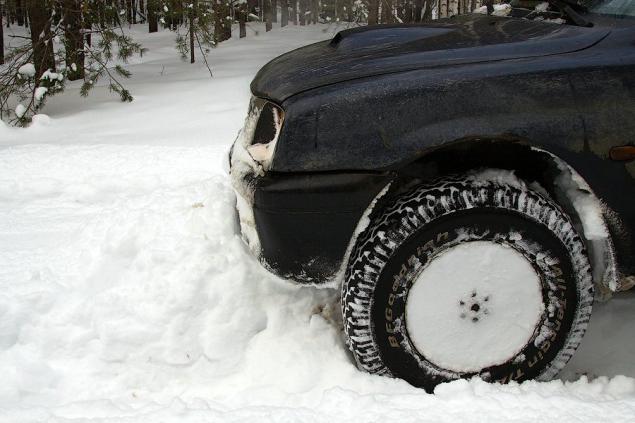
Source:
In summer 2011, forests and peat bogs near Moscow will again burn! It would not have comforted us by representatives of Roshydromet, no matter how many awards did not receive MOE officials, forest and peat about it do not know. They light up again as soon as the snow will melt. Moreover, peat bogs, and did not cease to burn. Back in November I wrote about the situation near Yekaterinburg (there is going to extinguish the peat is collected from the streets of snow).
And last Friday, we drove through the Lukhovitsy district of Moscow region in the vicinity of settlements Olshany and moss, along the road connecting the villages and Riasanovsky Beloomut and saw with my own eyes: burning peat. In the air is the characteristic smell that haunted us in the summer. Even the road here and there visible smoke. And this is where the power of the peat is quite small - a few tens of centimeters. About what is happening in the body of peatlands can only guess. We could not get there by car, but be sure to try to repeat in the near future.
Do they know that burning peat government and FEMA. They know, but do not hurry to recognize that this is a problem. Perhaps hoping for dozhlivoe summer, maybe just do not want the hassle, perhaps hoping that "will resolve itself." It does not resolve! And today it is necessary to prepare for the hot summer-2011.

Dead wood along the route. I showed photos from this autumn. And then it looked horrible, and now especially so because of the contrast of the image

03

04

05

06

07

08

09

Infamous Mokhovoe. The village burned for half an hour on July 29 last year.

11

12

13

14

15

16

17

18

And this is how looks the way smoke from burning peat.

20

21

In such places there is no snow.

A sort of "peat thawed." Even the grass is green somewhere preserved.

24

These unsorted debris will be an excellent fuel for new fires.

"Dumped Forest" - along the road only a few pieces of baldness.

27

usovevg at work.

Another sad sight - dead landing.

30

Houses holiday village "Star". We extinguished peat in September.

In several places smokes here.

33

One of the goals of our trip was the peat samples to further define its humidity.

Samples were taken just such a giant "corkscrew»))

Driller morskoy_pesik

37

38

39

40

41

Another section of the burned forest. Around 15 kilometers from the village Radovitsky.

43

A little further are even entire trees. But next year they, alas, has all chances to become like the photo above.

45

46

47

As I said, we were not able to get into the central part of the moor, even on our pepelats.

But we will come back to this region.
All photos: © Igor Podgorny
Drained peat bogs in the Moscow region continued to smolder, there is a risk of burning the resumption of the spring
Peat bogs in southeastern Moscow continues to smolder to this day. There remains a significant risk of renewed fires in the spring of 2011, after the disappearance of the snow cover, drying of the surface layers of drained peatlands and the debris of dead wood in the burned areas in summer 2010.
January 14 employees of Greenpeace Russia checked the pockets of smoldering peat Lukhovitsy district of Moscow region in the vicinity of settlements Olshany and moss, along the road connecting the villages and Riasanovsky Beloomut. From the powerful summer peat fire in the area within sight of the highway remained dozens of disparate pockets of smoldering peat dedicated to various enhancements and well-drained sites (dumps drainage ditches, roadside and others.). In places the snow thaws corruption to the surface peat. In four outbreaks in the vicinity of the highway, hand-drill wells were drilled to mineral soil underlying peat, in order to clarify what the power and the humidity of the peat deposits in the vicinity of the centers of corruption in the centers themselves. It turned out that two of the four seats of the residual capacity of peat is less than 30 centimeters and homes to spread corruption nowhere - they are guaranteed to be filled with water during the spring thaw, if not sooner. The other two centers of power peat more, and it is likely that corruption will continue until the new peat fire season. In the central part of Radovitsky drained bog moss these lesions can survive the spring snowmelt, can be much larger.
Drained peat bogs by fires of the summer of 2010, now represent a huge area, littered with charred dead wood, including in the areas immediately adjacent to some of the surviving homes smoldering peat. No signs of clearing burnt wood on peat, or pre-clearance, is not revealed. On adjacent to the swamp system of mineral lands of the forest, passed the fire, and basically died, but has not yet spilled. Some of these forests assigned to the sanitary clear cuttings, but the cuttings are not conducted. A significant part of forest preserved in the vicinity of the village watching Ryazanov not affected by the fires in 2010, is a culture of pine second age class with a lot of dead branches and dead organic matter on the soil surface.
There were no signs of work to extinguish remaining pockets of smoldering peat in this area is not detected.
Background.
Radovitsky moss bog system is at the crossroads of two regions (Moscow and Ryazan), and within the Moscow region - at the junction of three districts (Shatura, Yegoryevsky and Lukhovitsky). Drainage systems Radovitsky bog moss was started in the late XIX century Western expedition to drain the swamps led by General I.I.Zhilinskogo. Initially draining carried out in order to create conditions for the development of agriculture and forestry, as well as for the alloy timber on large drainage channels (in particular, via Žilina). In the 30 years of the twentieth century, dehumidification continued, this time with the aim of peat extraction. Around the 70-ies The twentieth century began the gradual dying peat industry (peat as fuel was not competitive in comparison with the gas), and the 90-ies peat bog system within Radovitsky moss almost ceased. Since peat is mined places in symbolic quantities for use in agriculture. Large Peat supporting infrastructure bilge, fire reservoirs and ensured the some level of protection from fires of peat bogs, have ceased to exist. Territory of the former peat bog system within Radovitsky moss in the Moscow region is now almost fully attributed to the lands of the forest fund.
From the time of General Zhilinsky drained bog system Radovitsky moss repeatedly burned. The most catastrophic fires, leading to a large loss of life occurred in 1936, 1972 and 2010
Since when has started to burn peat bog system within Radovitsky Moss in 2010, it is not precisely known (seems most likely that the first pockets of smoldering peat emerged in the first half of May). Close peat fire, apparently out-of-control, was recorded by satellite images (system FIRMS) in early July. On July 14, four kilometers east of the village watching Ryazanov has acted peat fire on an area of several hundred hectares, the fire quickly spread and covers all the areas. General Directorate of Ministry of Emergency Situations in the Moscow region at the time reported that "over the past day in the Moscow region emergencies not happened," and that peat fires are detected and eliminated (the information was repeated every day; now the official website of EMERCOM in Moscow These field reports deleted). Attempts to extinguish the fire were made, but the forces of forest workers and local fire department was too small to deal with such a powerful peat fire. For fire fighting aircraft has been used as the MOE, but the burning of peat on this area and in such a strong smoke its application could not be effective.
Until the end of July, a fire in the territory of the marsh system Radovitsky Moss continued to expand, and new hotbeds of burning peat. July 29 as a result of a sharp increase in the wind the fire quickly spread to a large area. As a result, burned villages and Kadanok Mokhovoe were killed according to official figures 10 people, according to unofficial - not less than 15.
Thereafter forces involved in the extinguishing of fires in the area, has been drastically increased (largely by volunteers, have no connection with official structures), the further spread of the fire was able to largely stop.
Throughout August 2010 EMERCOM in Moscow Region and the leadership of the ministry to report impressive success in extinguishing fires, while their actual size remained virtually unchanged until the beginning of the heavy rains in the late summer. August 8, 2010 Ministry of Emergency Situations Sergei Shoigu Minister said that his ministry "wanted a week dodavit fires" in the Moscow region. Already August 15 Ministry of Emergency Situations reported that the area of peat fires in the Moscow region was only eight hectares. August 19 Minister Shoigu held a final meeting of the Federal Emergency Headquarters at the Emergency Situations Ministry of Russia, which was officially announced that "in Moscow, Ryazan, Nizhny Novgorod region, the Republic of Mordovia setting wildfires fully normalized».
Peat meanwhile continued to burn even after heavy rains in late August and September. In early October, in the central part Radovitsky moss were still pockets of smoldering peat that gave the smoke plume is visible even on satellite images of low resolution. Gradually smoldering peat became less intense due to heavy rain and snow, arrays smoldering peat turned into isolated pockets, but these foci were observed within the vast territory traversed by fire in summer 2010.
Until the end of December 2010 the smoldering peat is only a concern of the local population, environmental organizations and forestry professionals. However, December 27 at the official website of the Ministry of Emergency Situations has been placed Forecast emergency situation in 2011, which not only recognized the existence of pockets of smoldering peat, but also spoke of the danger of the 2011 new fires from these centers. Quote: "save the threat of negative development lesotorfyanoy situation in the Moscow region in 2011. The basic premise is the preservation of pockets of smoldering peat at considerable depths (1-1, 5 m., Sometimes up to 2, 5 m.); which will contribute to the emergence of early fires (after the disappearance of the snow cover). " Even then, no measures to eliminate remaining pockets of smoldering peat has been taken.
It should be noted that the "forecast ..." MOE recognizes the existence of pockets of smoldering peat only in the Moscow region, while such centers of reliably known even in the Vladimir and Sverdlovsk regions, and, presumably, they may also be in the Ryazan, Nizhny Novgorod and Tver. This is the worst situation with foci smoldering peat observed at all even in the Moscow region, and Gus-Khrustalny district of the Vladimir region.
What can we all do.
Currently, due to the abundance of snow and the lack of road access to most of the centers of smoldering peat bog preserved within the system Radovitsky moss impossible. It is hardly possible now to arrange stewing most of these centers. In this regard, the main measures to be taken in the spring, immediately after the disappearance of snow cover. Pockets of smoldering peat can not immediately after the snow melts grow into full-scale peat fires, so they must be identified as soon as possible (no later than mid-May), and to take measures to contain and extinguish.
In addition, the necessary emergency measures for dismantling the debris of dead wood, especially in the areas drained peatlands. The best time to do this work for a long time is missed, dead wood on peat covered with snow. In the spring of demolition debris will require much more effort and costs, including financial. As far as possible to simplify the procedure removal of dead and decaying plants in sanitary felling, including state-owned enterprises under the direct estimated funding from the federal budget.
To ensure fire safety and the possibility of effective restoration in 2010 burned areas, possibly in the affected regions, it is advisable to suspend the operation of a number of standards of the Forest Code and related laws (including 94-FZ), the most hindering forestry. In the end, if the special federal laws effect of forest legislation was partially suspended in areas of the APEC summit and the Winter Olympics - why not extend this to the regions affected, and some other disasters.

Source:

